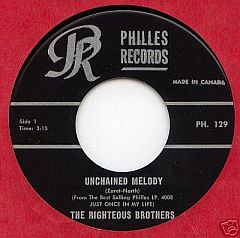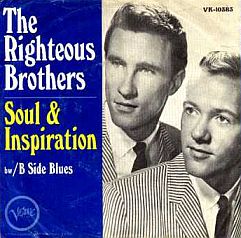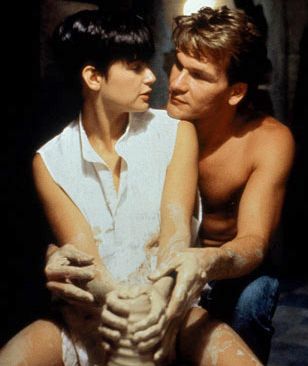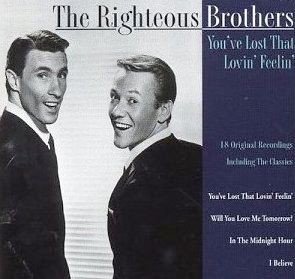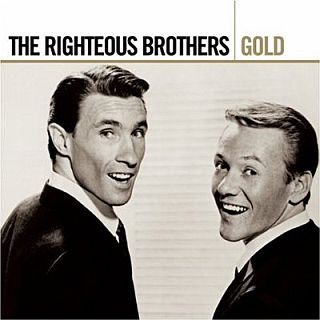
Early 1960s photo of Bill Medley & Bobby Hatfield on a 2006 issue two-CD set. Among songs included is the No.1 hit of 1965, 'You've Lost That Lovin' Feelin' '. Click for CD.
Music Player
“You’ve Lost That Lovin’ Feelin'”
(scroll down for lyrics)
Their stage name came about after a black U.S. Marine, attending one of their early nightclub acts, shouted out approvingly: “That was righteous, brothers!” The label stuck, and the two singers became a distinctive duet, with Bill Medley, the taller of the two, providing the bass-baritone, and blond-haired Bobby Hatfield singing tenor. Their style would later be dubbed “blue-eyed soul,” and there was no doubt about their vocal talent. They had a range and style that helped create a strong and distinctive sound. But they also had another potent ingredient in their music that helped make it distinctive — a music producer named Phil Spector.
Regarded as a musical genius in the studio, Phil Spector was then coming into his most productive years. With the Righteous Brothers, Spector made especially good use of their talents, packaging their songs in a distinctive way as he pushed the boundaries of popular music using his then-becoming-famous “wall of sound” technique. Spector’s sound used a flood of instrumentation behind good vocals that gave pop music a near-orchestral quality. His treatments became quite distinctive, often described as “full and powerful”; they changed popular music.
Spector himself, however, would also become known for his quirky and bizarre behavior, some of it violent, which years later would result in a second-degree murder conviction in the Los Angeles case of actress Lana Clarkson, for which Spector is currently serving a 19-years-to-life prison sentence. But in his earlier life, during his 1960s’ music production and studio work with the Righteous Brothers and other groups, Spector had magical abilities and was a much sought-after producer.
Honing a Hit
Said to have been inspired in part by “Baby I Need Your Loving” — a song by the Motown group the Four Tops (#11, July 1964) — “You’ve Lost That Lovin’ Feelin'” was written by the New York Brill Building husband-and-wife team Barry Mann and Cynthia Weil, along with Phil Spector. The production of the song went through many hours of experimentation, retakes, and studio time before it was recorded and released. As the Righteous Brothers’ Bill Medley would later recall: “Barry Mann wrote this ballad and I remember him telling me he wanted to write a song that was like the Four Tops’ records, and he wanted that kind of a song. So they wrote this ballad and Phil Spector and Barry Mann sat down at the piano and sang it to us. And they both had real high voices. And when they got done I said, ‘man, that’s a great song for The Everly Brothers’ — ’cause they sounded like The Everly Brothers. They had these real high thin voices. And I couldn’t imagine this was the song Phil Spector wanted to do with us… So we started learning it and the complexion of the song changed dramatically by trying to find the right key. The song has a pretty huge range to it….”
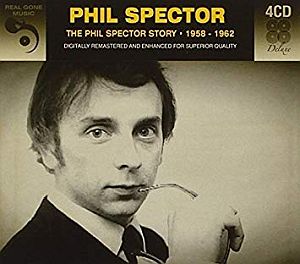
Phil Spector as he appeared in the 1960s, here on the cover of a collection of his songs. Click for comparable collection.
“The whole vibe of the song” changed, explained Bill Medley. But he credits “Spector’s phenomenal production” for making a song that was pretty unique. “Great song! Great production! And I think Bobby and I did a real good job.” Spector also had some back-up singers on the song, namely Sonny & Cher, before they hit it big on their own.
Years later, the Rock and Roll Hall of Fame would single out the song, and Spector’s production, at the induction of the Righteous Brothers. “Spector heard a deeper potential in the blend of Medley’s earthy thunder and Hatfield’s heavenly fire,” said the Hall, calling the song “magnificently produced” and citing it as a kind of “symphonic pop.” Spector’s wall-of-sound production technique on this song, said the Hall, “scaled unparalleled heights for a pop single.”
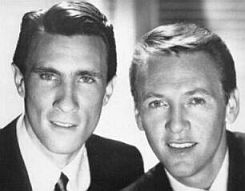
Righteous Brothers, 1960s. Bill Medley & Bobby Hatfield, in younger days.
“. . .The Brill Building – you know, that’s where they did all that great writing…. Where Barry Mann and Cynthia Weil, Carole King, and Neil Sedaka [were]; . . . just [where] all the phenomenal writers came from. Well, when it was time for us to go in and record we would just call Screen Gems and say, ‘listen, we’re gonna record on the ninth of January and we need a song and we will fly into New York to hear what you guys come up with.’ So we would fly into New York at a certain time and they would parade these unbelievable artists in to us. They would sing these phenomenal songs. None of them were bad. They were all phenomenal. And what a great problem to have; to try and pick the best song out of all these wonderful songs. So I’m sure we turned down several hits. Couldn’t do them all. Certainly would have liked to.” [For more on the Brill Building songwriters and that era, see the “Goffin and King” story, and also the Brill Building sidebar midway in the “1960s Girl Groups” story].
|
“You’ve Lost The Righteous Brothers You never close your eyes anymore You’ve lost that lovin’ feelin’ Now there’s no welcome look in your You’ve lost that lovin’ feelin’ Baby, baby, I’ll get down on my knees Baby [baby], baby [baby] Bring back that lovin’ feelin’ Bring back that lovin’ feelin’ |
Before the Righteous Brothers scored big with “You’ve Lost That Lovin’ Feelin’,” the two had performed on the September 1964 premiere of ABC-TV’s rock `n roll variety show, Shindig!, and they continued to make appearances on the show thereafter. They had also served as an opening act for the Beatles’ first America concert tour and later for the Rolling Stones as well. But once their songs began climbing the charts, they were soon in demand for their own act.
“Blue-Eyed Soul”
The Righteous Brothers’s sound, however, had fooled some listeners in the mid-1960s, including a few in the black community thinking the two singers were black artists. Black music was also then called “rhythm & blues,” or R&B music, having been changed from the previous “race records” label of earlier times.
In the 1960s, a number of cities with R&B radio stations were surprised to learn that the Righteous Brothers’ songs were those of two white performers. Rocky Grosse, Program Director at WWRL, a major R&B station in New York, was one of those with the mistaken impression.
George Woods, an on-air radio personality with WDAS in Philadelphia, is credited with coining the term “blue-eyed soul” to describe the kind of music these two white Righteous Brothers were then turning out — music enjoyed by both R&B and pop listeners. In fact, the Righteous Brothers songs helped open up the R&B radio stations to other white artists who also had a “soul sound” to their music.
“When we were both 13 we didn’t know each other,” Medley would later say about Hatfield and himself, “but our musical college was the same. Rock ‘n Roll caught us right at puberty. First time I heard Little Richard, my life changed. I would buy all these records by Fats Domino, B.B. King, Bobby Bland and Ray Charles and listen to them all day long. When it came time for me to sing on stage, I was trying to be like them. . . .”
Las Vegas Act
The Righteous Brothers quickly became one of the top groups on the music scene in the mid-1960s. They also became one of the first rock ‘n roll acts to play Las Vegas. As Bobby Hatfield later recounted about those times:
“. . .It was a great reception. We were working [The Sands] with Frank Sinatra. He was in the main room and we were in the lounge. It was a real thrill to meet and actually become friends with people like Frank Sinatra, Sammy Davis Jr., and Dean Martin. They were all working The Sands at that time…and Bill and I became …well, not close friends, but at least acquaintances, where they knew us by name and most of them just called us ‘the righteous boys’.”
Post-Phil Spector
By 1966 the Righteous Brothers left Phil Spector and the Philles label, making a better business deal with Verve Records. Verve bought the Righteous Brothers’ contract for $1 million. Their first song with Verve, “(You’re My) Soul and Inspiration” was also a No. 1 hit and a million seller. Bill Medley, who had some experience with sound production, was able to replicate a Spector-like “Wall of Sound” treatment for the duo’s new song. Through the remaining 1960s, however, they would have only a few more Top 40 hits.In 1968, Medley left for a solo career. Hatfield kept the Righteous Brothers going for a time with another singer, Jimmy Walker. But the act wasn’t the same. Medley had a couple of hits on his own, and for a time, neither he nor Hatfield did alone what they had done together. In 1974 they reunited for one hit, “Rock and Roll Heaven,” and in later years did some touring together on the oldies circuit and nightclub performing in Las Vegas and elsewhere.
Movie Power
However, two of the Righteous Brothers’ 1960s songs would later receive a boost from subsequent use in major films. “You’ve Lost That Lovin’ Feelin’ ” received a second run at the music charts in 1986 after it was used on the soundtrack of the May 1986 movie, Top Gun, starring Tom Cruise.
Music Player
“Unchained Melody” – Bobby Hatfield
In 1990, the Righteous Brothers’ “Unchained Melody,” featuring Bobby Hatfield, was used memorably in the Patrick Swayze-Demi Moore film Ghost, rising to No. 14 on the pop charts and becoming a million seller more than 25 years after its first recording. “Unchained Melody” also then topped the U.S. adult contemporary chart for 2 weeks and was No.1 in Australia for 7 weeks through January 1991.
In the U.K., meanwhile, “You’ve Lost That Lovin’ Feelin'” became the only song to enter the UK Top Ten three different times: once in 1965 when it was originally released, again in 1969 when it was re-released, and a third time in 1990 following Ghost, when “Unchained Melody’s” rise to No. 1 there also brought attention to “You’ve Lost That Lovin’ Feelin,'” which itself rose to No. 3 on the UK charts. “Unchained Melody,” however, was the best-selling UK single that year. In the U.S., a 1990 anthology album, Best of the Righteous Brothers, also became a million seller. In 2004, the American Film Institute listed “Unchained Melody” at No. 27 on AFI’s 100 Years…100 Songs survey of top songs in American films.
“Unchained Melody” is actually a song first written and recorded in 1955 when it was used in the film Unchained. It has since been covered extensively, with some 1,500 recordings, in multiple languages, made by more than 670 artists.However, the Righteous Brothers version from 1965 featuring Bobby Hatfield, who changed wording in one of the song’s later lines to “I need your love,” has become the classic.
Separately, in 1987, Bill Medley’s duet with Jennifer Warnes on “(I’ve Had) The Time of My Life” — a featured song in the film Dirty Dancing — topped the Billboard Hot 100 that November, and later earned a Grammy Award. The film’s soundtrack, with the song, also became a gigantic best seller — in fact, the most successful soundtrack since Saturday Night Fever, selling 14 million copies.
“Most Played”
In December 1999, Broadcast Music, Inc. (BMI) announced that “You’ve Lost That Lovin’ Feelin'” was the No. 1 song of the 20th century in terms of songs played most frequently on American radio and television. At that time, “You’ve Lost That Lovin’ Feelin’ ” had passed the 8 million “plays” mark. The 8 million ‘radio plays’ of “You’ve Lost that Lovin’ Feelin'” equals more than 45 years of back-to-back airplay. “One million continuous performances of a song of the average length of 3 minutes represents 5.7 years of continuos airplay,” explained BMI in its announcement. “The 8 million performances of “You’ve Lost that Lovin’ Feeling’ ” equals more than 45 years of back-to-back play.”
The Righteous Brothers’ songs have been covered by a number of groups. Elvis Presley, for one, frequently sang “You’ve Lost That Lovin’ Feelin'” and “Unchained Melody” during his 1970s performances. Dionne Warwick, Hall and Oates, and Neil Diamond, among others, have also done versions of “You’ve Lost That Lovin’ Feelin’.” Warwick’s version hit #16 in 1969, and Hall and Oates’ remake hit #12 in 1980.
Homesick Blues
But for some fans of the Righteous Brothers’ sound, there’s no substitute for the real thing. Here’s rock critic and writer Dave Marsh, recalling his memories of “You’ve Lost That Lovin Feelin” both as a young teen and in later adult years, as described in his book, The Heart Of Rock & Soul: The 1001 Greatest Singles Ever Made:
“…The [radio] deejay told me that this [song] was by the Righteous Brothers, who I already knew from TV’s Shindig. They were a Mutt and Jeff act. Somber-voiced Bill Medley stood way over six feet, dark and halfways handsome; tenor Bobby Hatfield was blond, five-five or so and greaser cute…
…Naturally, I bought the record, surprised at its red and yellow Philles label… So I sat and stared at the label and being in another line of work at the time — eighth grade — came to no unnecessary conclusions.. . . In the spring of 1987, staying at a hotel in downtown Chicago, I strapped on headphones and went for a run. . . I’d been on the road a couple of weeks, and felt home- sick, a little afraid, frightfully lonely. . . I loved the record (wore out one copy, picked up another used), harbored a half-secret devotion to the Righteous Brothers no matter what they did well into adulthood, moved on to other things, but still turned “Lovin’ Feelin'” way up whenever it came across the radio.
In the spring of 1987, staying at a hotel in downtown Chicago, I strapped on headphones and went for a run. There was a parade on Michigan Avenue, and I dodged in and out among the crowd until I got down by the lake, where there was almost nobody. I’d been on the road a couple of weeks, and felt homesick, a little afraid, frightfully lonely. The tape I listened to was composed of random favorites, deliberately jumbled so I couldn’t remember what came next. Somewhere over by the lake, “Lovin’ Feelin'” came on. I jammed the volume all the way up and the clash of those voices came through again. When they started begging and pleading — “Baby, baby, I’d get down on my knees for you,” sang Medley, “If you would only love me like you used to do,” responded Hatfield — tears sprang from my eyes. In the center of the continent, at the heart of a population of six million, I was suddenly, unmistakably, nerve-tinglingly abandoned and alone.
God knows what passersbys thought. But with the title — “You’ve lost that lovin’ feelin'” — echoing in my ears I understood at last: We worship the thing we fear…”
Recent Years
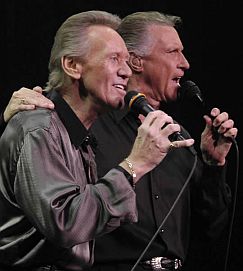
Righteous Brothers performing in later years.
See also at this website “To Know, Know…Him,” for more background on Phil Spector, or go to the “Annals of Music” page for additional story choices in that category. Thanks for visiting – and if you like what you find here, please make a donation to help support the research and writing at this website. Thank you. – Jack Doyle
|
Please Support Thank You |
_____________________________________________
Date Posted: 31 August 2008
Last Update: 26 February 2019
Comments: jdoyle@pophistorydig.com
Article Citation:
Jack Doyle, “Lost That Lovin’ Feelin’,”
PopHistoryDig.com, August 31, 2008.
________________________
Sources, Links & Additional Information
“The Righteous Brothers,” in Holly George-Warren and Patricia Romanowski (eds), The Rolling Stone Encyclopedia of Rock & Roll, Rolling Stone Press, New York, 3rd Edition, 2001, p. 824.
“The Interview” (1996), Righteous Brothers Official Website.
“You’ve Lost That Lovin’ Feelin’, The Righteous Brothers,” Rolling Stone, December 9, 2004.
“BMI Announces Top 100 Songs of the Century – ‘You’ve Lost That Lovin’ Feelin’ ‘ Is Number One,” BMI.com, December 13, 1999.
Dave Marsh, The Heart Of Rock & Soul: The 1001 Greatest Singles Ever Made, New York: Da Capo Press, 1999. pp.7-8.
“Righteous Brothers,”Rock and Roll Hall of Fame, Induction Year: 2003
Dave Thompson, “You’ve Lost That Lovin’ Feelin’ by The Righteous Brothers,” Song Review, All Music Review.
“You’ve Lost That Lovin’ Feelin’” and “The Righteous Brothers,” Wikipedia.org.
Richie Unterberger, “The Righteous Brothers,” Biography, All Music Review.
“Blue-Eyed Artists Herald Musical Integration of Airways,” Billboard, 1960s.
“You’ve Lost That Lovin’ Feelin’ by The Righteous Brothers,” Songfacts.com.
“Unchained Melody,” Wikipedia.org.
“America’s Greatest Music in the Movies,” AFI’s 100 Years…100 Songs, American Film Institute, June 2004.

